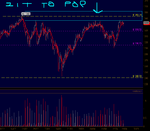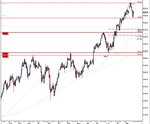Why would you think that? It's the number 1 topic in every book ever written about TA trading.
I would wager that if you took every unprofitable trader on the planet, the one thing they would all agree on is that S/R 'works'.
This is one of the reasons there is so much gameplay in those areas.
I would disagree on this. I mean, it IS the number one topic but I think the fact that it's the number one topic means a lot of people pass it over.
I think most people think: "if it's that simple, everyone would be doing it..." and so people move on, looking for other techniques, including the notorious indicators.
In all my time on these boards I cannot remember ever having anyone come to me and say "Hey Dante, I've been trading significant s/r levels and losing money hand over fist, can you help me?".
It's always been : "Hey Dante, I've been losing money hand over fist and I don't know why but let me show you the last trade I did...right, this Silver yeah, has been going up for ten days in a row and it looks extremely overbought up here...now yesterday it had a small down day so this morning I've sold the break of yesterdays low with a stop above the high..."
Maybe it's just me but that is my experience.
Now, onto S/R.
Contrary to my post that started all this, I do respect your opinions on S/R and I think you have made some good points but my personal feeling is that you approach the topic from the perspective of a short term trader.
There is nothing wrong with that but let me illustrate my argument with an example.
You trade the ES; so here is an ES chart.
There is a significant s/r pivot at 1295. There is nothing hindsight about this. I had it drawn on weeks ago. It is as clear as day.
Now have a look at chart 2.I know a trader that bought that at 1295 (His reasoning? Price trades into a good level).
The trader in question has made a lot of money from this trade having exited at 1333.
But that's a moot point.
The question I put to you is this.
In your opinion, based on this H1 chart:
Did 1295 work as support or did it fail?
Price broke that area by 5 ES points. I will make a wager right now that most short term ES traders will clearly say "Support Failed". I worked with "the professionals" and I can tell you with a good degree of confidence that there is almost zero chance that any one of them would still be in that if you threw them in long at 1295.
So here is the follow up question. What makes the trader in my example profitable by buying these levels? (and let's stay away from, he's not, because he IS)
Is it that his stop is wide enough not to get shaken out if the smaller retail get squeezed? (Incidentally his stop was 7 ES points after spread)
Here's one more example. I've taught people S/R and in the cases where they are not profitable, aside from psychology etc which I believe is next to impossible to teach - the common problem is they are buying every single level looking for a reaction.
Lets move to chart 3. I will make a call of sorts here since the examples have been hindsight.
The purple areas are obvious s/r levels. Agreed?
I personally, would not buy at either of them. Sure, price may react to them but there is only one place I would consider buying that S&P and that is at 1318. And it would have to go lower than 2 or 3 ES points to get me out.
I don't have a Limit Buy there at the moment. I am discretionary and I will watch price if it makes it's way down into the level but the fact remains that is the ONLY level I would buy that at on the immediate downside, no matter what I saw.
The only thing that will change that is new price structure that shifts probabilities and makes you reasses.
So, in light of this new example, how reliable is S/R, despite me calling myself an S/R trader?
If I have no faith in the purple levels and wouldn't touch them with a bargepole, do I have no faith in S/R?
Or is there something more?
One final point: As an S/R trader, I have much more success trading FX than I do the ES.
Is S/R more reliable on some markets than others? If I take a trade in the USD/JPY (for example) off S/R, the majority of the time, I barely go offside. If I do so in the ES, I do often get squeezed a little before it comes good.
So, "is price action and S/R, really price action and S/R" regardless of the market?
All serious questions. I'm enjoying the thread.





